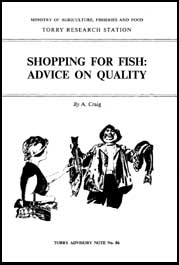Contents Index

Accompanying Notes
Table of Contents
By A. Craig
MINISTRY OF AGRICULTURE, FISHERIES AND FOOD
TORRY RESEARCH STATION
TORRY ADVISORY NOTE No. 86
Crown copyright material is reproduced with the permission of the Controller of Her Majesty's Stationery Office.
This electronic document has been scanned using optical character recognition (OCR) software and careful manual recorrection. Even if the quality of digitalisation is high, the FAO declines all responsibility for any discrepancies that may exist between the present document and its original printed version.
Advises on how to choose and buy good quality fish and shellfish and store them at home. Gives information on live, wet, frozen and smoked fish products. Advises the shopper to make full use of the expertise of the fish seller, and to try the less well known species. Distinguishes briefly between some terms that are often used too loosely, such as wet fish, fresh fish and freshness. Fresh can be used strictly to mean, having the characteristics of newly harvested fish, or more loosely to mean, having no significant sign of spoilage, such as off-odour or off-flavour. More importantly, it should not be used to mean fish that has never been frozen, because such fish could be stale, and it should be noted that it is illegal to offer for sale described as fresh (i.e. unfrozen) fish that has been frozen and thawed. Read in conjunction Note 91.
(FAO in partnership with Support unit for International Fisheries and Aquatic Research, SIFAR, 2001).
Introduction
Buying fish
Storing fish at home
Contents Index